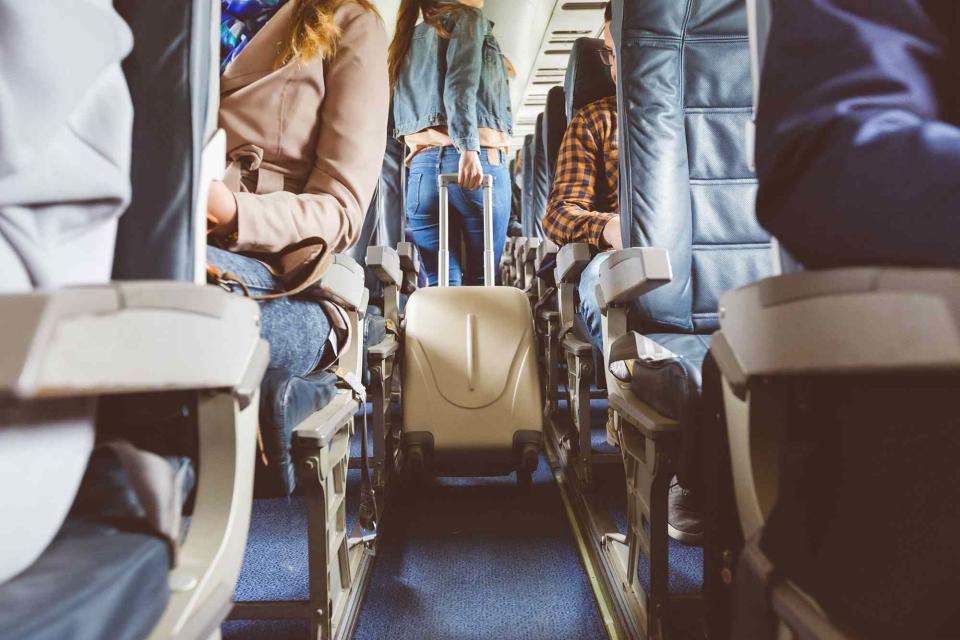Why Airlines Board Planes Front to Back — and a Better, More Organized Approach, According to an Astrophysicist
Astrophysicist Dr. Jason Steffen says there's another way.

izusek/Getty Images
The worst part about flying isn't the flight itself. It's not even airport security. What's always a pain is boarding the aircraft. There's something utterly chaotic about the process, from the jumbles of people crowding the gate to the shuffling down the aisle before being blocked by someone in front of you attempting to put their bag in the overhead bin (which they'll often do the wrong way). There must be a better way, so why do airlines board front to back?
More often than not, airlines use a process called block boarding to load passengers onto a plane. In this system, each passenger is assigned a zone, and one zone boards at a time. In block boarding, the zones aren't necessarily separated by rows on the plane; they're actually designated based on factors like cabin class, frequent flier status, whether or not you hold an airline credit card, and fare class. Given this hierarchy, the first zones generally cover passengers in the front of the aircraft, while the later zones cover passengers in the back.
For example, Zone 1 is usually first or business class, along with passengers who hold top-tier elite status — these people often sit up front. The economy cabin is typically boarded in the higher-number zones, unless you have an airline credit card or frequent flier status that might bump you up to an earlier zone. But the last zone (Zone 6 on United, Zone 8 on Delta, and Zone 9 on American Airlines, in case you're wondering) is for passengers who booked basic economy tickets, and these seats are assigned at the last minute, so they can be anywhere in the economy cabin. See how this can get confusing?
Most airlines use block boarding because it incentivizes passengers to either book premium cabins, achieve frequent flier status, or sign up for an airline credit card to be in a better boarding zone — and therefore have space in the overhead bins for their carry-ons. (The lower your zone, the later you board and the less likely you are to find storage space.)
Even though block boarding is a prevalent boarding method, it isn't the fastest one. In 2008, astrophysicist Dr. Jason Steffen, a professor at the University of Nevada, Las Vegas, devised his own method for boarding an aircraft, commonly referred to as the Steffen Method. Mathematically, it allows passengers to board faster than any other approach, from block boarding to back-to-front to front-to-back.
Steffen's method is fairly complex: Airlines board passengers with window seats first, then middle seats, then aisle seats. And, crucially, they must board in alternating rows. "The best way to board passengers is to have them spread out throughout the interior of the cabin so they can all put their luggage away without getting in each other's way," Steffen tells Travel + Leisure. "This would mean boarding all of the passengers on even rows, seat A first, then going to the odd rows, then the other seats."
To figure out this boarding process, Steffen used a statistical modeling method called the Markov chain Monte Carlo that helps determine optimal routes. "Basically, I board the passengers in my computer model, then randomly change two passengers and see if it boards faster or not," says Steffen. "If yes, keep the new order. If no, flip a coin and keep the new order depending on the result. Over time, the passengers will tend to organize themselves in the fastest order." And thus the Steffen Method was born.
The problem is that while the Steffen Method works in computer simulations, humans regularly introduce errors into a process, thus slowing it down. And that's not to mention the fact that the method would end up splitting up groups sitting together, which might not be preferable for many passengers. "Airlines have a variety of competing demands they are trying to optimize, not just the speed of passenger boarding," says Steffen. "Some may adopt some of the principles my method exposes, but I don't know that any will switch completely."
Till then, when it comes time to board your aircraft, you'll have to take a deep breath and exercise patience — everyone makes it to their seat eventually. But for everyone's sake, please don't get in line until your boarding zone is called.
For more Travel & Leisure news, make sure to sign up for our newsletter!
Read the original article on Travel & Leisure.


